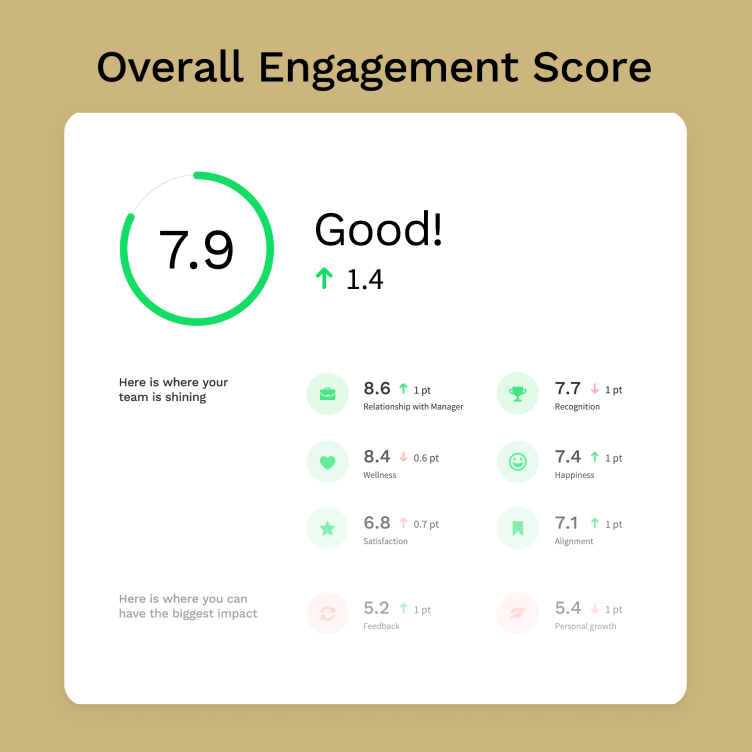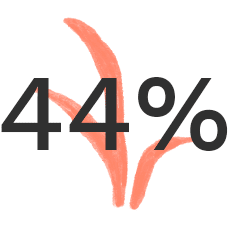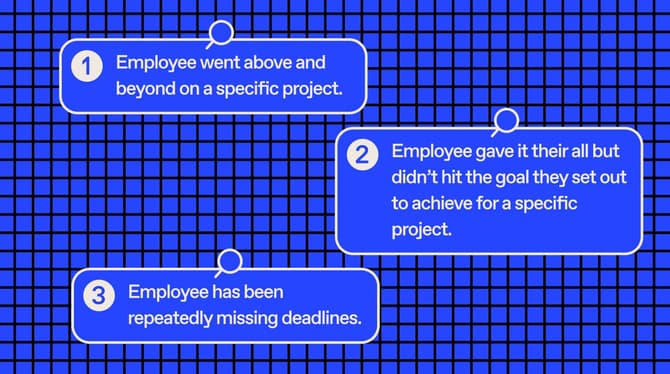When you gaze out over your team, whether at the office or on a grid of video feeds from home, what do you see? Not their to-do lists or deadlines or productivity stats. No, you see faces, expressions, and attitudes.
Sure, people aren’t as easy to read as a spreadsheet or report, but one thing emotionally intelligent managers should always try to gauge is how motivated their people are. Remember, motivation levels aren’t pre-determined. They are the result of applying your managerial soft skills, and motivation is top among them.
Exclusive online summit
·
May 23 2024
Moments that matter: how to seed great work
What's in this article
Why employee motivation can be tough right now
Things have changed. Strategies, work processes and team dynamics have been affected. We’re all adapting to new realities. Things that kept us motivated at the office we may not have at home. Everyone is living in different circumstances. Some are revelling in remote work, while others are feeling lonely or needing to manage parenting and working at the same time. This can affect you, the manager, as much as anyone on your team. And it’s admittedly difficult to motivate when you’re not too motivated yourself.

Before you jump into motivation solutions, it’s important to understand where everyone is on the motivation spectrum. Ask your employees how they’re feeling with our Officevibe surveys and feedback tool to track engagement. You’ll be able to see clearly where things are going well, and where they aren’t, while offering a safe space for employees to share anonymous feedback. This will help you get important conversations started, then you can build solutions based on your findings.

2 different kinds of motivation in the workplace - intrinsic and extrinsic
What does motivation mean in the context of work? Once upon a time, the simple answer was the paycheck, but a study from Psychology Today reports that money ranked far below other factors when it comes to employee motivation. The figures speak for themselves:
- Camaraderie, peer motivation (20%)
- Desire to do a good job (17%)
- Feeling recognized (13%)
- Having an impact (10%)
- Growing professionally (8%)
- Money (7%)
This doesn’t mean that fair compensation is not essential, it just means that there’s a lot more to motivating people than dangling a carrot. To get into this, let’s break down the idea of motivation into two types: extrinsic motivation and intrinsic motivation
1. Extrinsic motivation: motivating employees with external rewards
Money and rewards are the best example here. Someone does a job, and their time and energy are then indirectly translated into monetary compensation. The problem with extrinsic motivators alone is that they don’t necessarily engage your employee more than the minimum required.
How do employees feel about the extrinsic motivator of compensation?
Thanks to our Officevibe data, we have some insights for managers on compensation:

of employees don’t feel satisfied with the benefits their organization offers.

of employees do not feel that they are paid fairly based on their skills, experience and efforts.

of employees don’t think that the way pay is decided is fair.
So, don’t bank on compensation alone to motivate. You need a more profound tool in your motivational toolkit. Aside from money, you can play around with more fun ideas, like extra days off or a free lunch.
2. Intrinsic motivation: motivating your employees with internal rewards
Intrinsic motivation is about doing something for its own sake — for the satisfaction of doing it, enjoying it, and seeing it done well. There are many things you can do as a manager to internally motivate your employees to do their jobs with such gusto.
In work, intrinsic motivation comes from:
- Getting involved in the decision-making process
- Seeing the impact of one’s work in a bigger picture
- Being able to learn and grow while working
- Enjoying the work and caring for your team
- Being able to do what you love and hone in on your strengths
When you put your best efforts into intrinsically motivating your employees, you demonstrate you care and are all-in to see them develop under your leadership.
6 ways to motivate your employees in their day-to-day
Keeping your employees motivated every day is a full-time job. Before we explore some concrete things you can do on a day-to-day basis, let’s lay down the high-level principles of employee motivation:

- People need a sense of involvement in defining their roles and setting goals,
- People need to see how their individual contributions have an impact,
- People need to know they have the freedom and autonomy to experiment, and
- People need to feel a sense of commitment to their team and to you, the manager.
Here are some good tips to keep in mind when applying intrinsic motivation.
1. Inspire a sense of purpose
Everyone on your team needs to feel a sense of purpose in the big picture and to see how their individual efforts help your team get there. Working personally with each employee to define their roles and set their goals is a great motivator. This also gives them the chance to reflect on their strengths and map out where they’d like to improve.
Tip: With a new hire, ask them to write up a job description, not of the job they think they’ve been hired for, but of the dream job they want. Then see how you two can make it a reality together.
2. Offer autonomy and the freedom to fail
You need to allow your employees the space to be creative, to try new approaches, and even fail. These are great learning experiences. More importantly, granting autonomy (especially during remote times when managers may inadvertently turn to micromanaging) demonstrates that you trust them, a true intrinsically motivating force.
Tip: Thomas Edison once said, “I have not failed. I've just found 10,000 ways that won't work.” Why not offer an Edison Award — recognition for the most interesting or educative way something didn’t work, and then share learnings for next time. It’ll take the edge off of not-succeeding, encouraging people to get creative.
3. Make work a place to grow
A sure way to motivate employees is when their job lets them do more than what their basic title prescribes. When work offers opportunities to develop one’s skills and learn new ones, employees know that their efforts will pay off in ways more valuable than just a salary.
Tip: Encourage employees to take time outside their day-to-day tasks to learn something new: a coding language or even soft-skill training like public speaking, then share their new skills and learnings with the team.
4. Build connection with employees
It’s nice to see that 84% of employees from our Officevibe data feel like they’re part of a team. When employees care about their team and their manager, they’re more motivated to work hard for their sakes.
Considering the times we’re in, relationships are key to getting buy in for change. If you need to communicate a new strategy, change in direction, or touchy news to your team, they will receive it better because they trust and care for you.
Motivation is key to engagement. Send your team our inspirational quotes to keep them motivated, engaged, and ready to do their best work.
How to motivate employees during times of change and uncertainty
Here are some pieces of advice and actionable tips to help you transition to the work-from-home era without losing any motivational steam.
This is a must: keep communication lines open
Keeping communication clear, authentic and constant is key to securing your team’s continual buy-in for potential changes: shift strategies, budgets, team structure, processes, etc. People appreciate being kept in the loop and feeling part of the decisions that are made.
Tip: Hold a “What’s New” meeting regularly that’s short and to the point: Have there been any changes your team should know about?
Be reassuring, but also realistic
Find the balance between taking the time to reassure employees and answer their questions, but also be real with them. If things aren’t going well for the business, don’t sugar coat it, but do explain it to them. People want to understand the reality they are in, and feel motivated when they are included in finding the solution.
Keep your eye on the prize, but also on their feelings
Informal and regular one-on-one meetings shouldn’t stop just because you can no longer grab a coffee together. Keep up with everyone individually to see how they’re faring at home without their team and colleagues. Take this time to be open about how you want to be a better motivator. Listen to each individual’s take on what motivates them. You might be surprised at some of the answers you get.
Try asking:
- “What kind of workdays do you most look forward to?”
- “Which way do you prefer to be informed of difficult news?”
- “What makes a task exciting to you?”
- “What makes a task difficult to begin?”
Recognize little wins, and make it meaningful
When you recognize a job well done, that’s intrinsic motivation at work. It should be timely and specific, not broad comments on everyone’s work over an unspecified period of time. Right now however, 40% of employees in Officevibe don’t feel recognized enough by their managers. Especially during these more trying times, employees need to be appreciated for their contributions, even if they’re not hitting the bullseye of your original goals. Let people know you see them doing their best.
Managers need motivation too
Motivation is a double-edged sword for managers. You keep your team motivated, but who’s motivating you? A lot of managers we’ve spoken with are especially worried about staying motivated in times of remote work. You’re only human, so don’t be hard on yourself, but do ensure you have the same support you’re handing out.
- Talk to managers from your company or others. See how they’re holding up and what they’re doing to motivate themselves and their team.
- Ask your team to share their favourite managerial moments with you, the times when you most helped them keep going and pushed them to smash their goals. Keep doing that.
- Let your boss know what you need from them to stay motivated, whether it’s more clarity, more frequent touchpoints, or more recognition. To be a good manager for your team, ensure you have a good relationship with yours too.
- Mostly importantly, take the guesswork out of wondering how your team is feeling and how they feel you’re doing as a manager. Keep lines of communication open with Officevibe’s insightful surveys and anonymous feedback tool. Track metrics like Relationship with Manager, Job Satisfaction, and Happiness at Work every week so you know exactly what to put on your to-do list to keep your team engaged.
Remember, your team’s performance is a reflection of yours and vice versa. And it’s motivation that functions here as a positive feedback loop, making you and your team want to work harder for each other.



